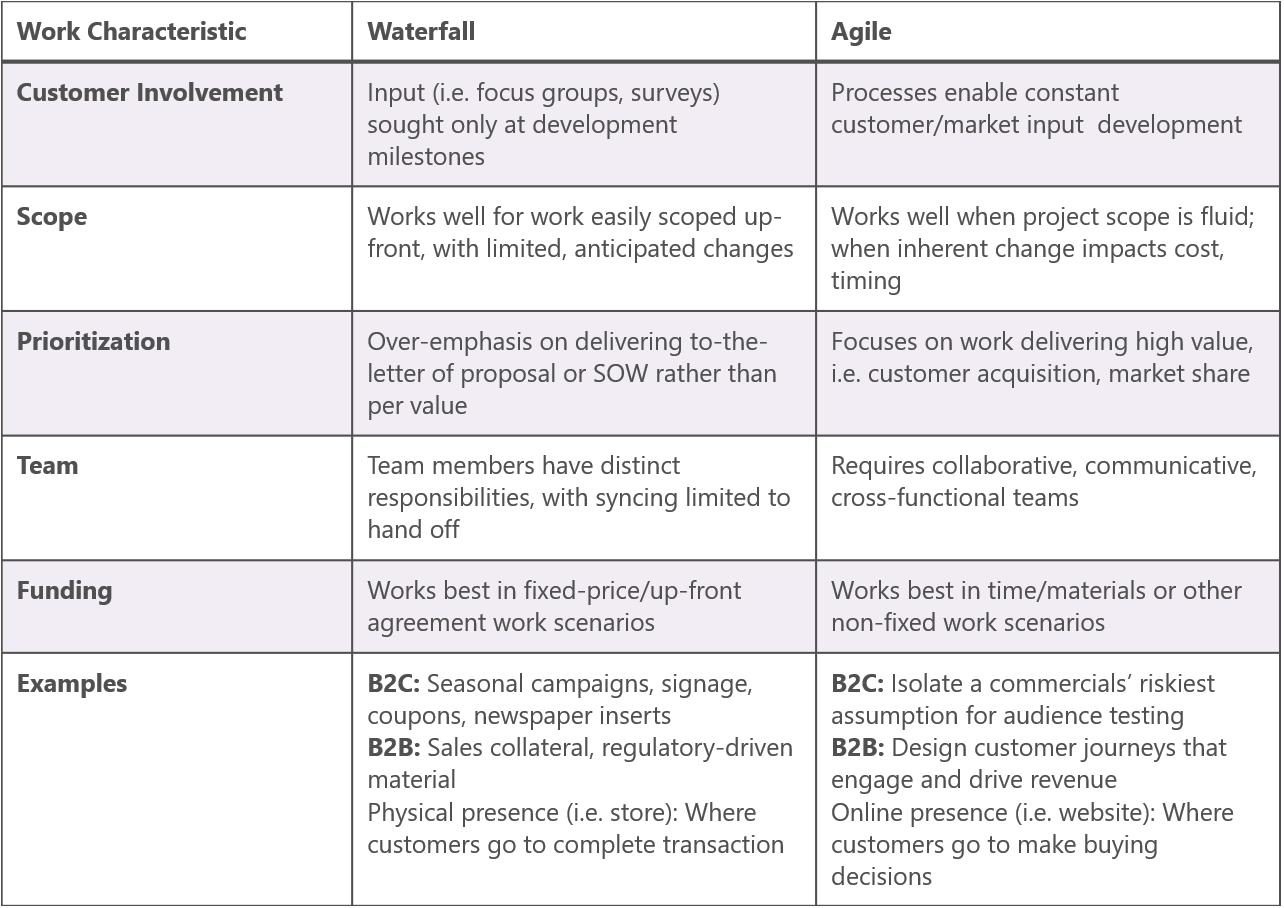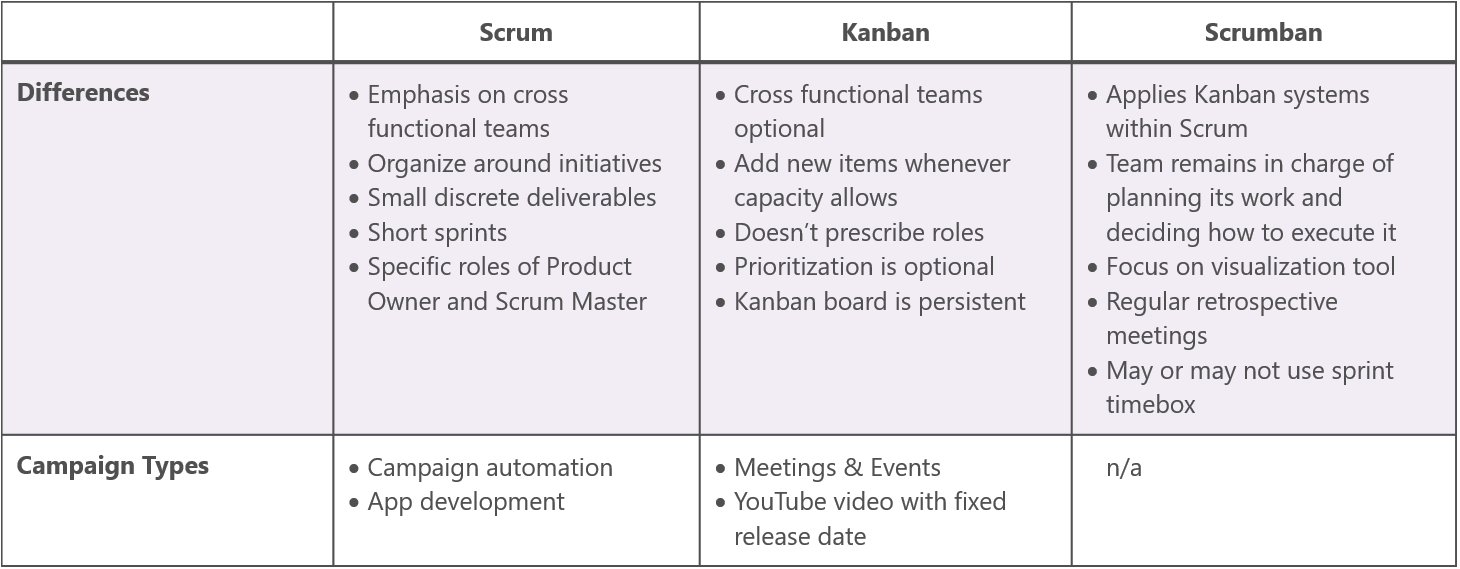
Unpack Misconceptions to Properly Apply Agile for Marketing in a Digital World
Many marketing leaders are advancing from a waterfall mindset, incorporating agile approaches to the way they work. They’re helping their agencies and marketing organizations do more than just improve their digital marketing. These trailblazers are improving how they ubiquitously “do marketing” in a digital world—providing the timely, personalized experiences that draw customers to their products or services at scale.
The rate of agile adoption is growing. Thirty-seven percent of marketing organizations are in the process of making the move, according to Andrea Fryrear of Agile Sherpas. Groups that have truly embraced Agile are 3x more likely to significantly increase market share than those who haven’t adopted, according to a recent Forbes/CMG Partners study.
If there’s that kind of potential in Agile, why aren’t more marketers adopting the approach?
In our experience, the fact that marketing has been structured much the same for the past 30 to 40 years makes such fundamental change difficult. Many marketing leaders appreciate that old ways of working do not fit the new environment, and can even commit to change; however a shift to Agile is often ambiguous and leaders are not quite sure how to get started.
This blog gives those who want to move forward information and answers to help them make the first steps.
We believe agile principles, techniques and tools can (and should) be applied to all types of agency and marketing work—although perhaps not all at once. We’ve found that those who have yet to embrace Agile likely have a misconception of what Agile is all about, and therefore struggle to figure out how it fits with both traditional and digital development.
To add clarity, let’s unpack Agile: first, by understanding when Agile should apply; and then, discerning which flavor of Agile is right in varying circumstances.
1) When Should Agile Apply?
The two approaches we are referencing, Waterfall and Agile, are defined as follows:
Agile is not only suited for digital development. To understand how Agile can be applied to different types of work, we need to dig deeper.
A B2B logistics company with a 12-person marketing org developed a plan to test Scrumban practices for their annual tradeshow in just a few days, and was able to start incorporating daily standups and WIP limits immediately. While the rest of marketing was still managed using Waterfall, the agile pilot helped build momentum around adopting the new management model, and got people talking about what they liked or didn’t like about the agile methodology.
A B2C retailer with a large global marketing organization may be wary of a total agile transformation, especially when day-to-day operations are constantly changing and moving at high speeds, but knows that something has to be done to manage the work load better. By introducing a work-estimation system based on story points into the existing waterfall project management, and identifying the maximum available “points” across the team, marketers gain familiarity with agile terminology while taking small, practical steps towards broader organizational change.[/column][/grid]
As with any approach, Agile has its advantages and disadvantages. It is not suited to every project or context. It works very well for services that are always on (like marketing automation), moderately well for programs that have a regular cadence (like a monthly webinar), and least well for one-off initiatives. The established Agile methods range in their degree of structure (Roland Smart).
How do marketing leaders new to Agile determine what work is Agile-inclined, and what work lends itself better to Waterfall? Here’s a guide2:

A typical marketing organization would ideally incorporate both approaches, aligning the teams and skills to the nature of the work. Doing so requires thoughtful integration with a target operating model.
The target operating model is a marketing organization’s architecture. It is the structure set up to maximize synergies across teams while providing freedom for each team, answering the questions: What do we outsource, what do we retain? What is offered by shared services? Are teams aligned to segments, channels, etc.? What foundational frameworks are necessary to coordinate work across teams? With this model in place—to accommodate both Waterfall and Agile—figuring out which types of work are Agile-inclined is the smart way to start.
Once you decide which of your work will be developed in an agile setting, it’s time to figure out which approach to Agile meets your needs.
As depicted The Agile Marketer, Smart describes Agile made up of several methods and practices1:

For marketing, there are two ways to approach Agile—Scrum and Kanban—and they’re not the same. Understanding their difference is critical to understanding how Agile can be applied to traditional, digital, online and offline activities. Said another way, not all Agile is the same: Scrum will make sense for some work, and Kanban will make sense for other work.
To define:
Here’s a guide for determining what lends itself better to Scrum, Kanban and Scrumban1:

While there are distinct differences that suit one method over another, all agile approaches1:
For most, in-house agencies and corporate marketing groups will be using both Waterfall and Agile in the foreseeable future, unless your firm is undertaking a broad transformation.
In this hybrid state, leaders and managers can coordinate disparate teams by leveraging the tools they already know to link the plans and campaigns. These tools—editorial calendars, messaging architectures, brand guidelines, etc.—enable each approach to bring value to marketing, and should permeate both centralized and decentralized agency/organizational models.
Project management tools can also help. Broad enterprise tools, like Workfront, can manage both waterfall and agile projects in the same environment (if deployed properly ), or pure agile tools, like Trello and LeanKit, can allow for increasing maturity in agile practices.
Deciding under what circumstances it makes sense to continue with the status quo, and when it’s necessary to employ Agile to deliver on the customer experience at scale will be an ongoing deliberation with all stakeholders. Incorporating agile principles is rarely a simple go/no-go decision. It’s more nuanced than that, and often requires identifying and coaching small teams and expanding from early successes.
Further, transitioning from waterfall processes, structure and operations to an agile approach—be it Scrum, Kanban or Scrumban—requires taking a close look at the specifics of the business to determine what types of marketing needs to change to become more flexible and responsive—and what needs to stay the same.
As always, we welcome your comments.
-------------
1 From The Agile Marketer, www.rolandsmart.com
2 Adapted from Segue Technologies